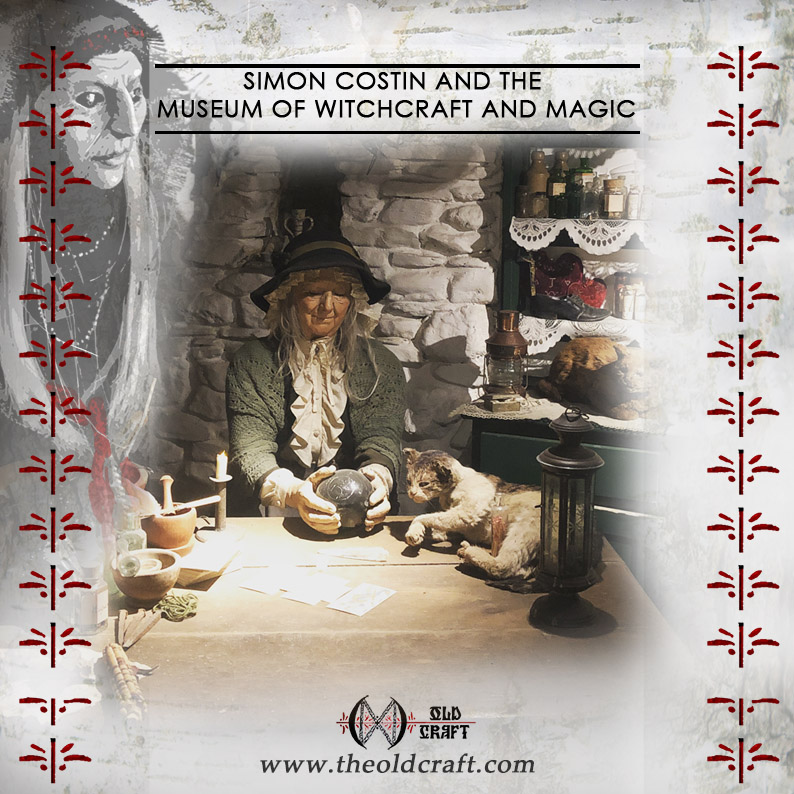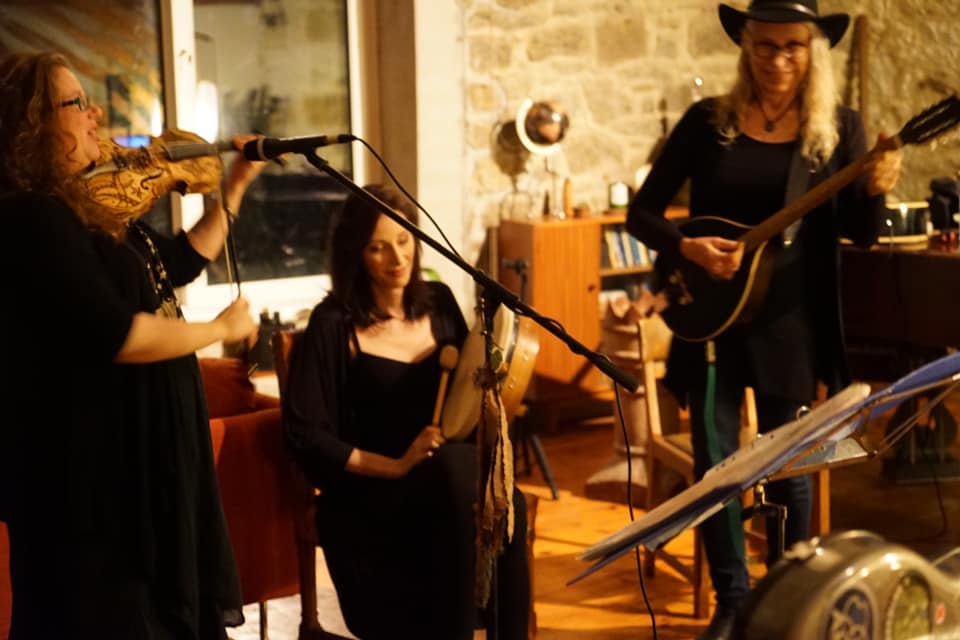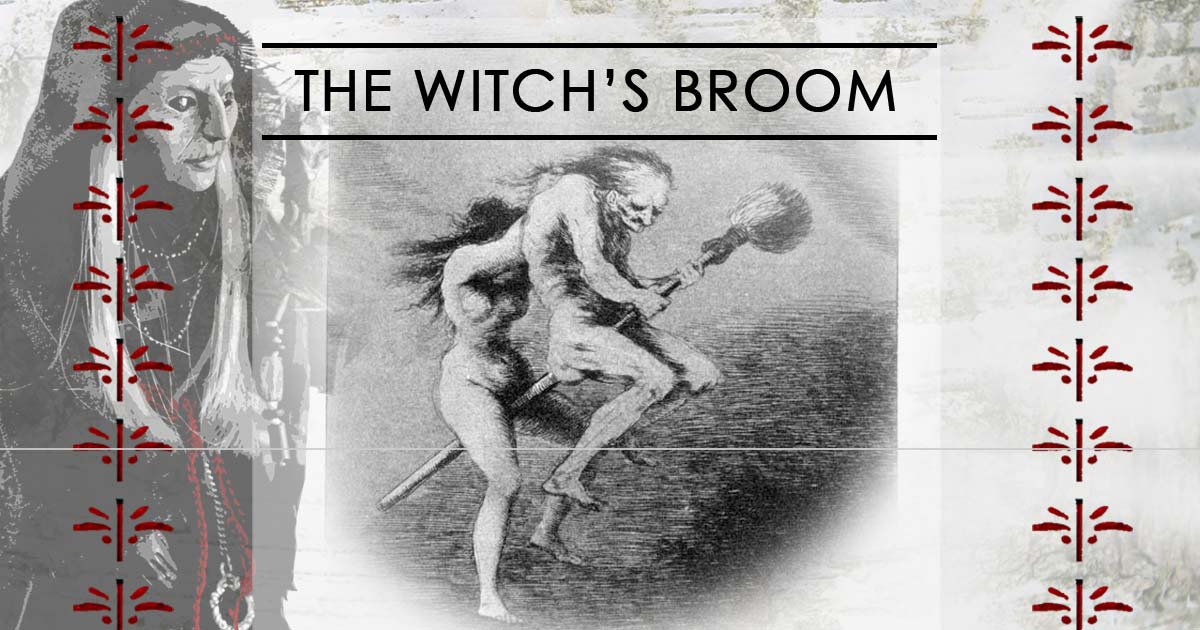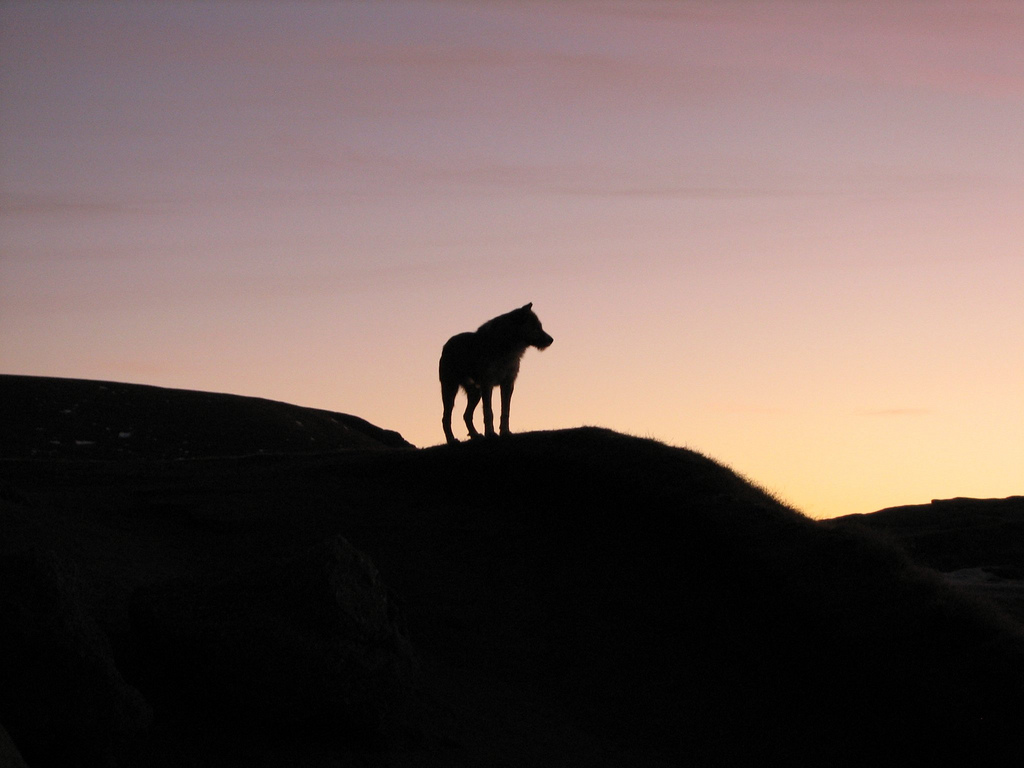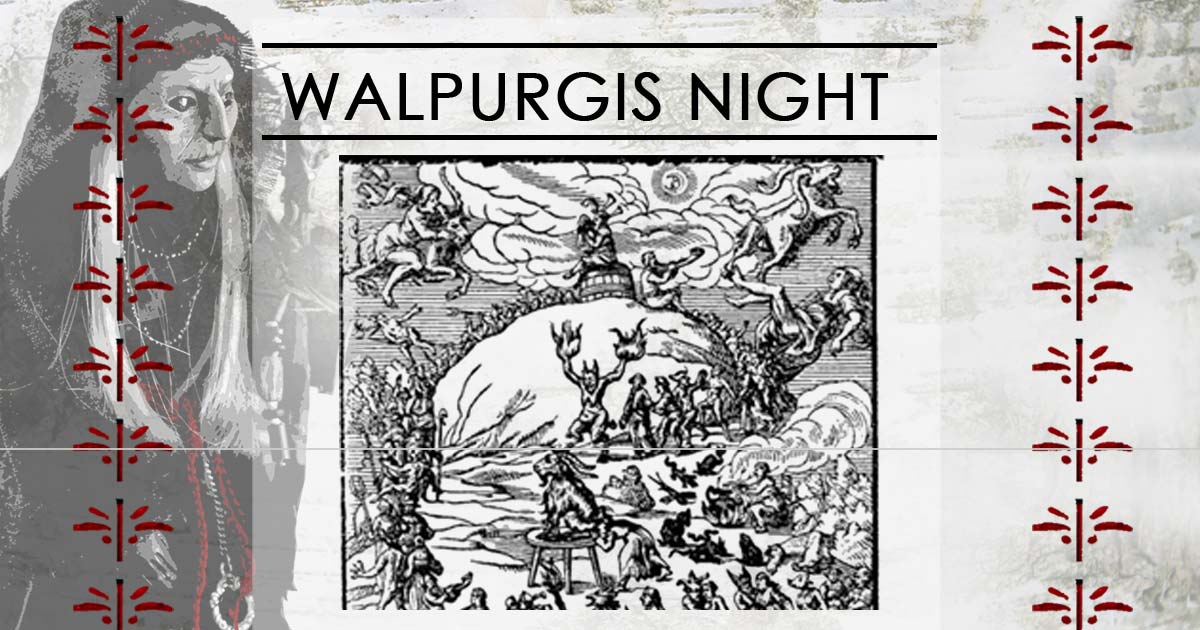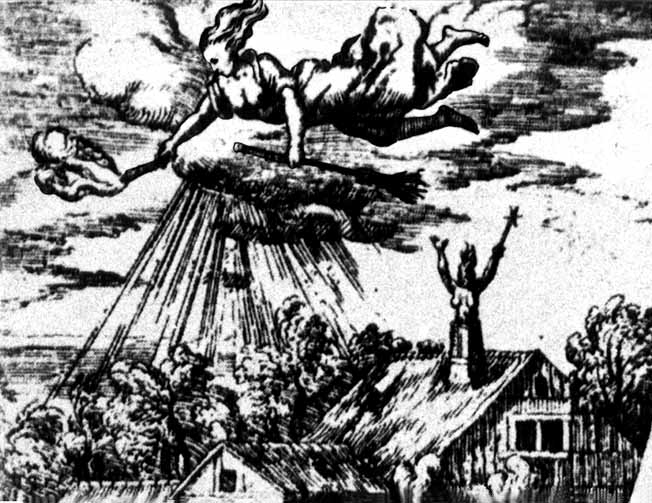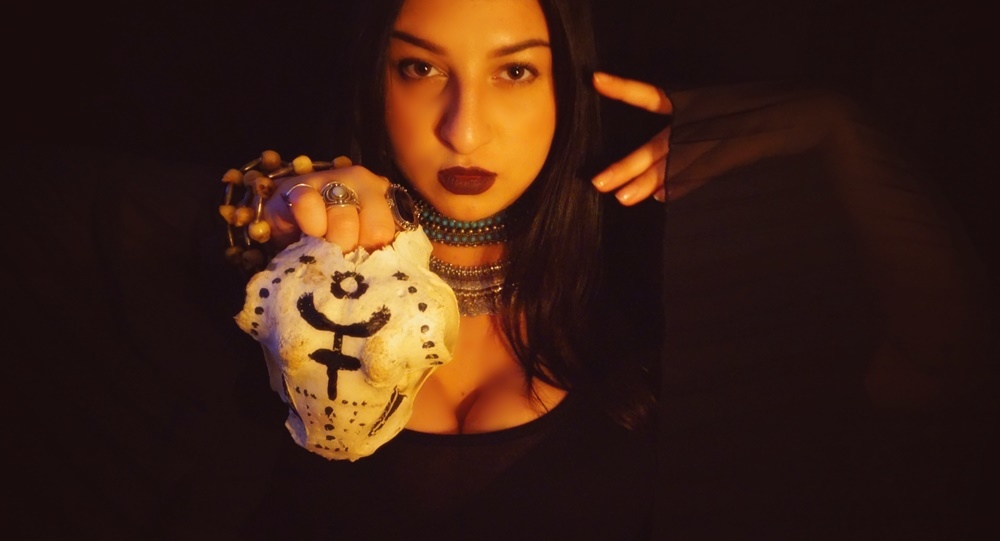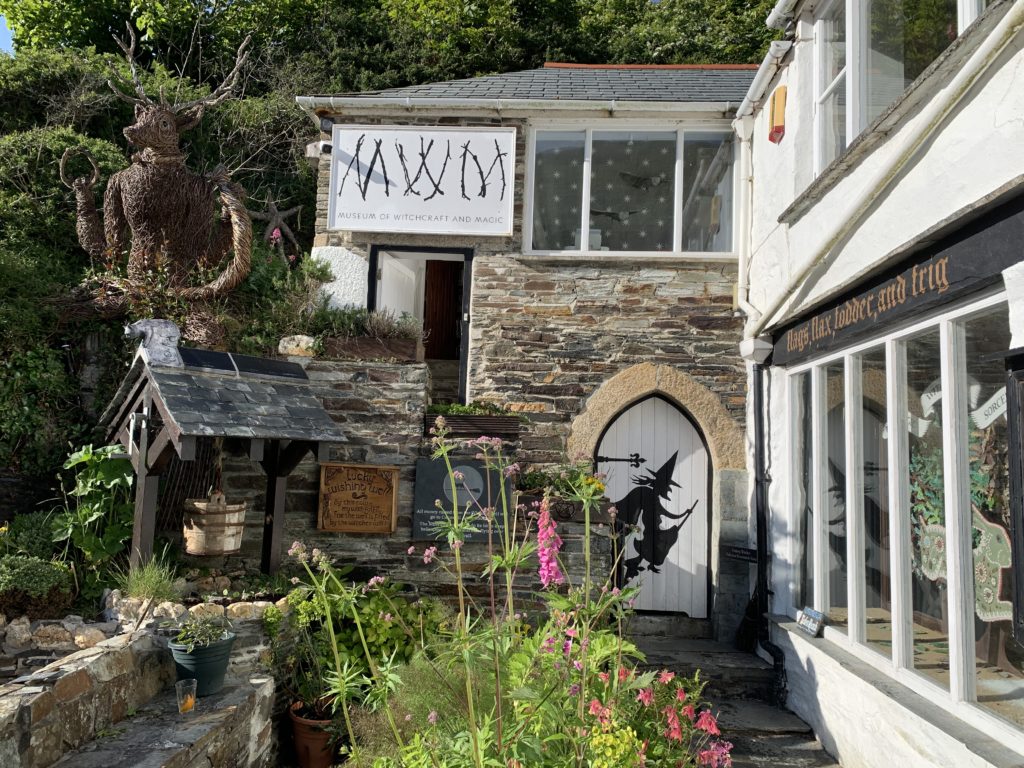
Entrance to the »Museum of Witchcraft and Magic«. While the »MWM« logo is a recent development, the witch flying on a broom has been (with some interruptions) on the doors since the beginning. Foto: © Museum of Witchcraft and Magic
The »Museum of Witchcraft and Magic« celebrates its 60th anniversary this year on the mystic-romantic shores of Boscastle, Cornwall, and at the same time can prepare for its 70th birthday next year, 2021 having opened in 1951 on the Isle of Man originally.
The history of the museum has been full of change and colorful events: after a failed attempt, due to the opposition of locals, to found a witchcraft museum in 1947 in England, Cecil Williamson opened the first version of the museum, »The Folklore Centre of Superstition and Witchcraft«, in an old mill on the Isle of Man in 1951. Gerald Gardner, the founder of Modern Wicca, joined Cecil as the resident witch in the museum and the museum’s name later changed to the »Museum of Witchcraft«. The repeal of the British Witchcraft Act in 1951 finally legalized the practice of Witchcraft after hundreds of years.
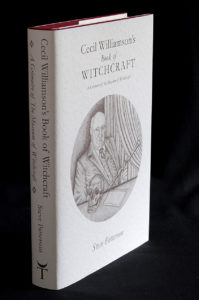
Cecil Williamson (18 September 1909 – 9 December 1999) founded the Museum of Witchcraft and Magic in the 1950’s. He was himself a witchcraft practitioner, friend with Wiccan founder Gerald Gardner, collector of folklore, editor and screenwriter and film director. The book by Steve Patterson, published by the cornish »Troy Books« publishing house, introduces readers to his life, work and magic. Foto: © Museum of Witchcraft and Magic
Gardner and Williamson had established their friendship in 1946 after meeting at the »Atlantis« bookshop in London. The same bookshop where I met Simon Costin earlier this year for Wilmar Taals book launch about the Gnome manuscript – a part of the Richel Collection, which is a set of magical notes and papers housed in the archives since the ’90s in the museum.
But first things first: after being involved in the financially largely unsuccessful museum Gardner and Williamson’s friendship broke down and in 1954 Gardner purchased the museum keeping its doors open until his death in 1964. It’s contents ended up undeservingly by being sold off in 1970 by Gardner’s heir and High Priestess, Monique Wilson to the »Ripley’s Believe it or Not« company, an American franchise focused on sensationalism. All of Gardner’s artifacts have now been sold off through private sales once Ripley’s wanted to get rid of them.
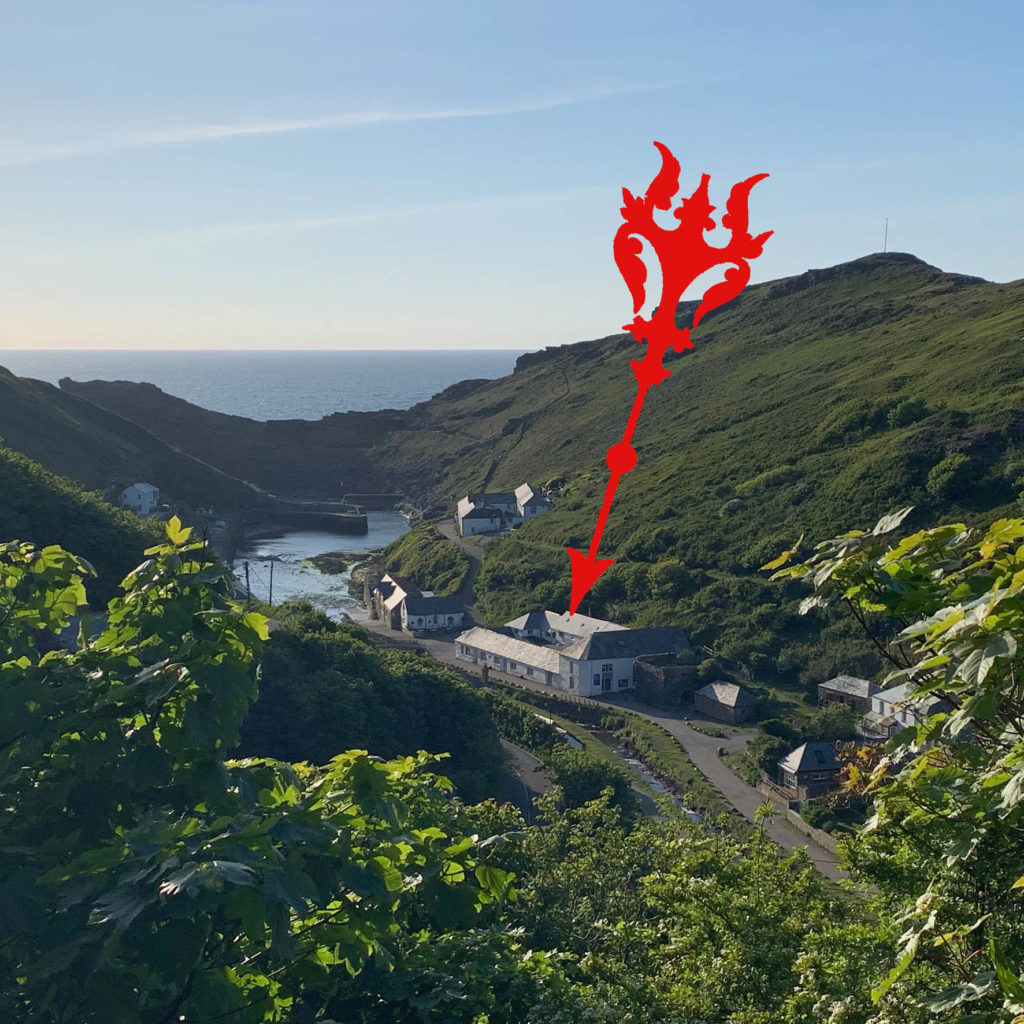
Boscastle is a village in Cornwall, England, and lying at the confluence of two rivers – Valency and Jordan. After several rejections and violent resistance, Cecil Williamson found here in the 1960’s, near the harbor the final location for his witchcraft Museum.
Meanwhile, Cecil Williamson returned to England after the break with Gardner and founded his own »Museum of Witchcraft«. But both in Windsor, Berkshire, and the next at Bourton-on-the-Water, Gloucestershire, violent reactions to the museum forced him, once again, to search for another place for his museum. In 1960, Williamson found this on the shores of Boscastle, where it has resided now for over 60 years. In 1996, three years before his death the now 87-year-old Williamson sold the museum to Graham King. King incorporated the Dutch, Richel Collection in 2000. But Graham also pushed the museum into a more scholarly direction. He was also the one to bury the skeleton of Witch Joan Wytte, rather than continuing to have her on display.
But in 2004 the museum was threatened again – this time by a series of flash floods which damaged the village and the harbor extensively. Only due to Graham’s vigilance, who noted the upcoming threat in time, greater damages and loss of life could have occurred. Graham’s engagement earned wide recognition and the Museum of Witchcraft received support even from the London Museum of Geology to replace broken display cases. It reopened in 2005.
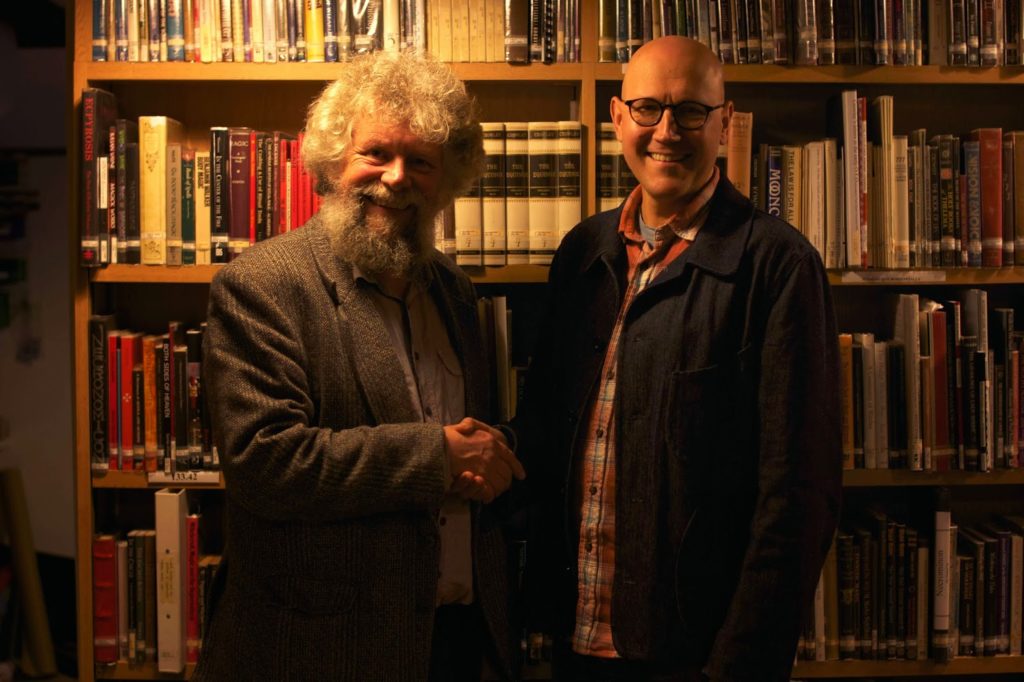
Roughly 3 years before his death, in 1996, Cecil Williamson sold the museum to Graham King (left in picture). King was likewise a witchcraft practitioner and lead the museum until 2013, when he transferred the ownership to Simon Costin (right in picture). Foto: © Museum of Witchcraft and Magic
The artist and art director Simon Costin, founder of the Museum of British Folklore, felt the urge to help and support the museum. Soon King offered Simon an internship, where Simon fell in love with the museum and everything in it. Simon and Graham became friends. After 17 years of being the director of the museum, Graham transferred the ownership to Simon and his Museum of British Folklore in 2013. Simon renamed the museum, the Museum of Witchcraft and Magic, and also continued the charity around it, the »Friends of the Museum of Witchcraft and Magic«, which was set up in 1997. So, Simon promised to look after the museum and continue its good work. And if we talk about continuity, we also need to talk about challenges and how to face them. Thus, we are happy to find Simon ready to do an interview with theoldcraft.com:
AH: This year the museum is closed for the entire year due to Corona. You arrived actually some four months before the planned reopening in April to prepare for this year’s season and then had to spend lockdown in Boscastle. How have you and the museum been since then? How is the team?
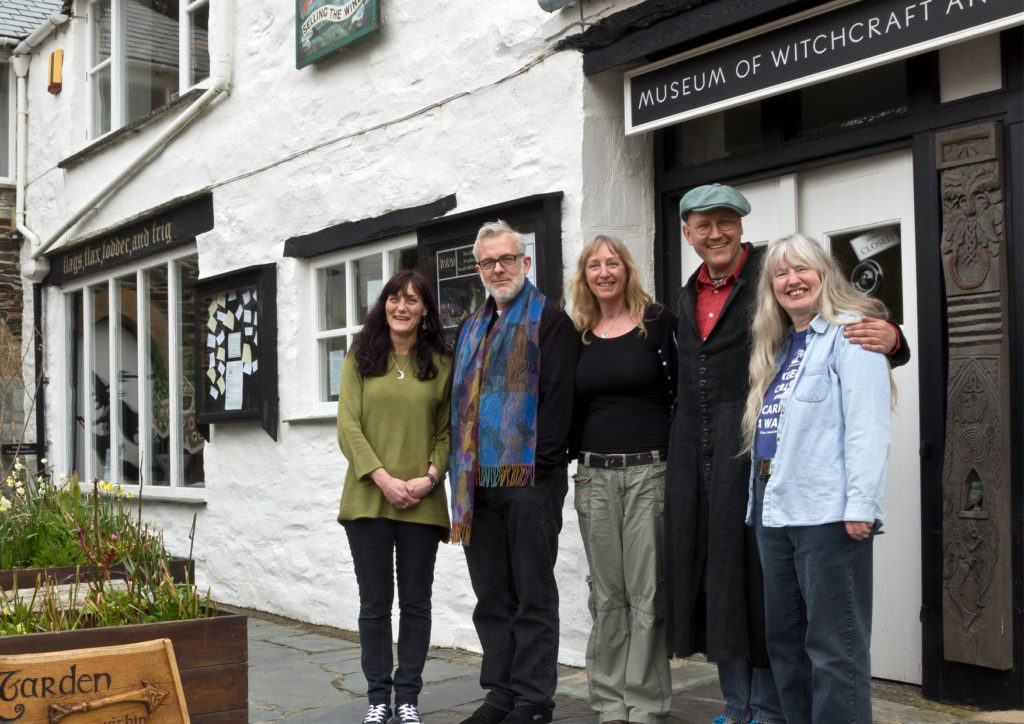
The entire team consists, at the time of writing, of five people: From left to right, Hannah, Fergus, Gypsy, Simon, and Joyce. Foto: © Museum of Witchcraft and Magic
Simon Costin: This is the second time in the history of the museum, that it has been forced to close for such a long time, so it took all of us some time to get used to. The first time was due to a flood and now its due to plague!
We have all had to adapt to the new circumstances and have been using our creativity to survive. We have created a new zine, Conjuration and have introduced new shop stock that we have been able to sell by promoting it on Instagram, which has really helped us. Normally we survive from the door takings with paying visitors so this year we have had to look at alternative ways of paying our bills.
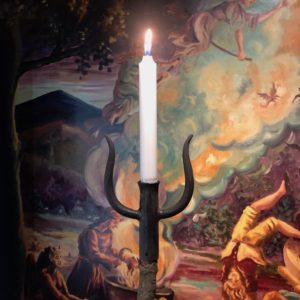
A symbol of the horned god: many witchcraft traditions know something called the stang: a staff with a forged top and a shoe. In the picture, we see a candle version of the stang. Like for all museums, selling merchandise and books to visitors has been an important part of the financing. As the MWM had to remain closed this year due to COVID-19, the webshop plays an important role as an alternative source for funding. The stangs are available as staff and candle version, and both are hand-forged on Bodmin Moor, Cornwall. The shop features several other magical tools and accessories, ranging from incense and spell sets to music collections, jewelry and books. Foto: © Museum of Witchcraft and Magic
AH: You used to commute and travel a lot, this year thanks to lockdown you had the opportunity to stay in Boscastle for a longer period. You even announced to move there for good and are currently selling your house in London. This sounds like lockdown had also positive side-effects. Can you tell us more about how all these came to be?
Simon Costin: The decision to move from London was made a year before Covid 19 came to be. My work at the museum, along with my own personal art practise, are the things I now want to focus on and moving to Cornwall is a large part of that. I am also in the process of establishing the UK’s first ever Museum of British Folklore and the collection is stored in Dover, where I’m lucky enough to have a house. My intention is to spend time in both Kent and Cornwall. Lockdown has only slowed this process down rather than helping it!
AH: I planned a visit for this year, probably many other readers will have the same question now: can we hope for a visit next year?
Simon Costin: We are looking at ways to enable us to open. Visitors will need to book a time slot online to be able to visit, so that we can control the amount of people we have in the building at any one time. This way we can comply with the covid regulations and insure that our visitors are protected. We hope to open on April 1st but updates will be posted on our website.
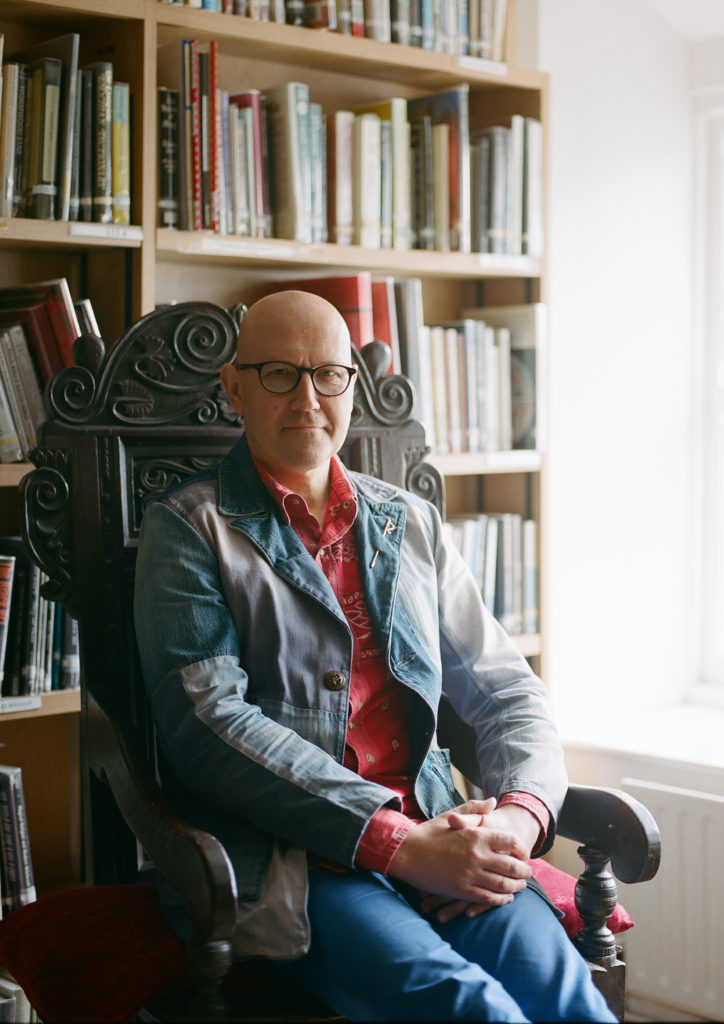
Simon Costin, born 1962 in London is a British artist, set designer and curator. He works with luxury fashion brands and has artwork in the collections of the »Metropolitan Museum of Art« in New York, such as the necklace »Incubus« or »Memento Mori«. He is also the founder of the »Museum of British Folklore«, which stages exhibitions across the UK while searching for a permanent home. Foto © Crista Leonard
AH: Cecil Williamson practiced Witchcraft, Graham King was involved in Witchcraft, you often use shamanic and magic symbolism in your art. Are you a witch, too?
Simon Costin: I would say I was an Occultist or a Magical Practitioner rather than a witch as such, although you could say a lot of witches are magical practitioners! I don’t like labels and always try to avoid them. My practise and beliefs have changed and developed hugely over the past 38 years and I no longer feel the need to categorise what I do or how I structure my relationship with the forces that I choose to work with. It works for me and that’s all that matters really.
AH: So how did your relationship with the occult start and develop over the years?
Simon Costin: Who knows where these things start. My parents kept many of my childhood drawings which were always of strange and esoteric subjects and looking at them now, they seem to point towards a young mind trying to make sense of a growing awareness that there are other levels of existence and that we are much more than purely material beings. I wouldn’t say that the drawings were dealing with the spiritual in a traditional sense but they were certainly exploring what we might think of as ‘spiritual realms’, other ways of seeing and experiencing the world we find ourselves in. This later grew into a realisation that the way in which we generally experience life as children and young adults, is a very free and ambiguous one and that as we grow older and mature, we can become more rigid and analytical about the way in which we interpret lived experiences. The key to magical practise, for me, is to get back to an earlier state of being where our intuition and subconscious are allowed to be tapped into in a more immediate way. Artists and creative people do this naturally and some of the most magical people I’ve met are also wildly creative. Magical practise and creativity compliment each other. My art practise and my magical practise go hand in hand.
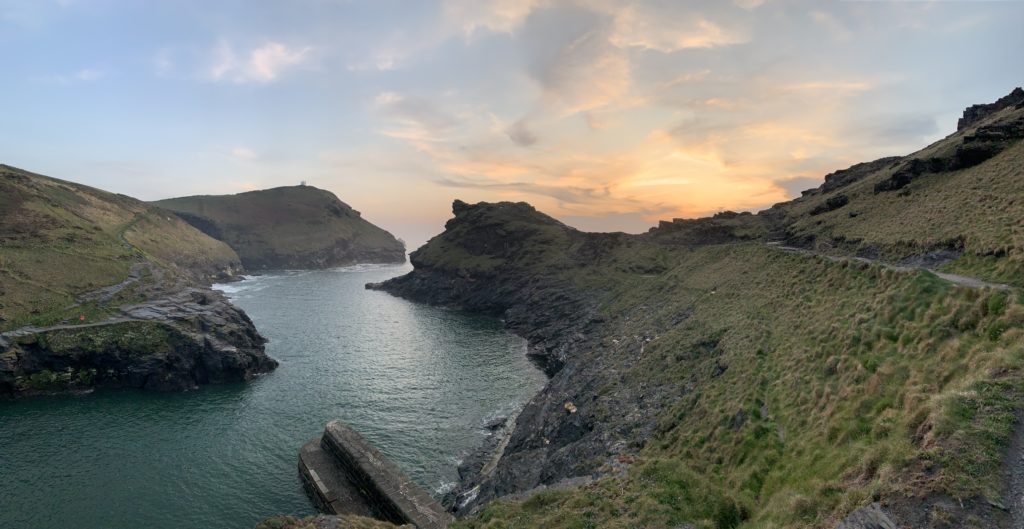
Simon Costin: »Boscastle is uniquely situated at a point where the Valency river flows into the open sea. There was a distinct feeling of a strong genius loci here«. Foto: © Museum of Witchcraft and Magic
AH: What made you fall in love with the museum after the flood and what makes you most happy being the director?
Simon Costin: The first time I visited the museum it was not only the collection that spoke to me but the place in which the museum sits. Boscastle is uniquely situated at a point where the Valency river flows into the open sea. There was a distinct feeling of a strong genius loci here, and one that I felt the need to develop a relationship with. Like any relationship, there was a period of courtship followed by a degree of wooing and step by step my love for the museum and the location deepened and grew. I hope that Graham King, the previous director, could sense what was happening and ultimately felt happy to hand over the reigns. On October 31st 2013 I became the next custodian of the museum and signing the paperwork felt like a marriage.
I think the thing that makes me most happy is seeing the collection grow and develop, along with the way in which the objects are interpreted.
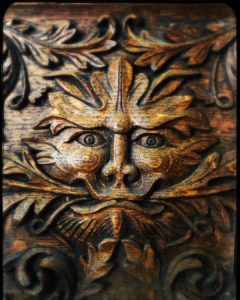
»The Green Man« from the collection of the »Museum of British Folklore« is one of the common motifs and synergies between the two museums Simon Costin is engaged in. Foto: © Simon Costin
AH: What is the connection between the Museum of Witchcraft and Magic and the Museum of British Folklore, whose founder you are?
Simon Costin: British Folklore is a passion of mine since childhood, when my parents used to take me on holiday and we would come across some strange and uncanny seasonal customs, of which there are hundreds which take place across the UK. It has always amazed me that there is no museum which cherishes and celebrates the vernacular culture of the British Isles. The project is ongoing and we have organised exhibitions across the UK in various locations while we search for funding to build a permanent home for the collection. Of course there are many cross-overs between witchcraft, magic and folklore, so the two projects sit next to each other very well. Our current exhibition looks at the Folklore of Cornwall for instance, with tales of the Piskie folk, the Bucca’s and fairy changeling babies.
AH: You are an art director, curator, and artist yourself. Indeed the museum has one of the most stylish websites on the occult internet. It more than once occurred to me that I listed it in my day job in briefings as a reference for good style, next to DG and Alexander McQueen. Besides style and your passion: what do you want to bring to the museum in the next decade and what is your vision for it?
Simon Costin: The decision to update the website was to make it easier to navigate, be engaging and to bring it in line with current museum practise. The style came as a result of that and was not the driving factor. I like things to be clear and visually interesting when it comes to a website.
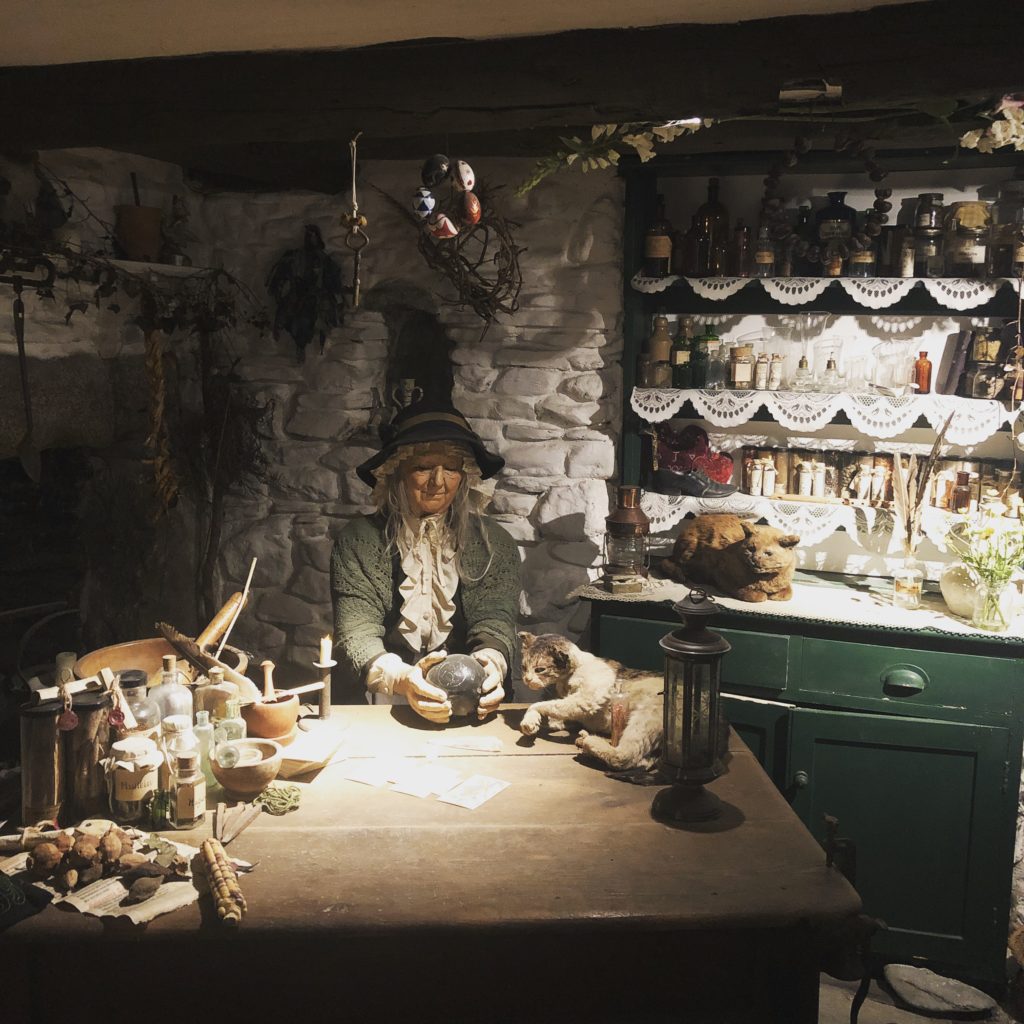
The »wise woman’s cottage« in the MWM. Under Graham King, the museum introduced a more scholarly approach. Instead of focusing on the witch as an evildoer, the focus was shifted to the healer and wise woman. Foto: © Museum of Witchcraft and Magic
As far as the museum is concerned, I began looking at the narrative that was woven through the collection when I took over, which was started by Cecil Williamson. Graham King had decided to do away with Cecil Williamson’s vivid but dated tableaux and to instil a sense of order to the collection, which in some way reflected the currency of the museum with the then contemporary audience, increasing in number, many of whom were not just craft practitioners or occultists, but artists and writers, and a more informed general public. The museum was divided into sections; Herbs & Healing, Protection, Cursing, Divination etc. Building on previous presentations, my own distinct vision intends to present objects in an increasingly poetic way by blurring the boundaries between them, and indeed sometimes between contexts in all forms of diverse practice. After all ‘Curse or blessing, wound or weal – that which harms can also heal’. For me, categorising magical objects is a little like trying to measure a cloud with a ruler. I want the objects to tell their own story and for the text that we may choose to go alongside them to hint at how they may have been used because in many cases, we do not know exactly how they would have been used. A human bone in the hands of one practitioner could be put to a completely different use in the hands of another. By trying to explain too much, you can destroy the magic, so I hope to bring some poetry and nuance to the collection and to use lighting and shadow to conceal as much as reveal.
I also intend to update the last gallery in the museum to bring things up to date. I am a collector by nature and am constantly on the hunt for artefacts to enrich the collection. The museum represents a vast repository of neo-pagan belief and history and it is the role of any director to see to it that the collection reflects those beliefs as best as it can and to act as a resting place for magical objects which elsewhere, may not find a home or could be lost to generations to come.
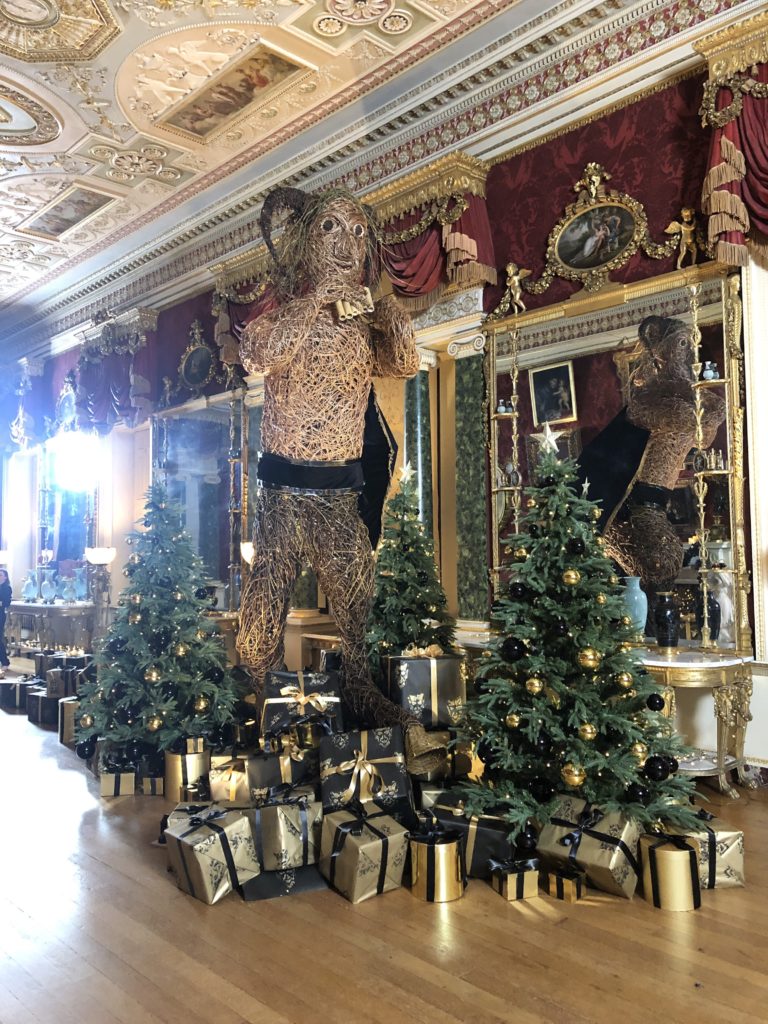
An installation of the god Pan in one of Simon Costin’s set designs for Yule time. Foto: © Simon Costin
AH: As an artist, you also use occult symbolism in your own work. For example, the necklace you made called, Incubus in the MET refers to the five elements. How else does the occult influence your art and work?
Simon Costin: That’s quite a difficult question to answer. Magical thought affects everything I do and informs both the way I see the world and the way in which I live my life. It would be difficult for me to divorce myself from it, so its influence is all consuming and pervasive in everything I do.
AH: The stock of museum items is still growing and you constantly add to the collection. For example the drawing “The Witches Boat” in 2019. Do you actively search for new items? What are the criteria on which you decide to add an item to the collection or not? And is the museum the right place for magicians and or their families to donate their items after going into the otherworld?
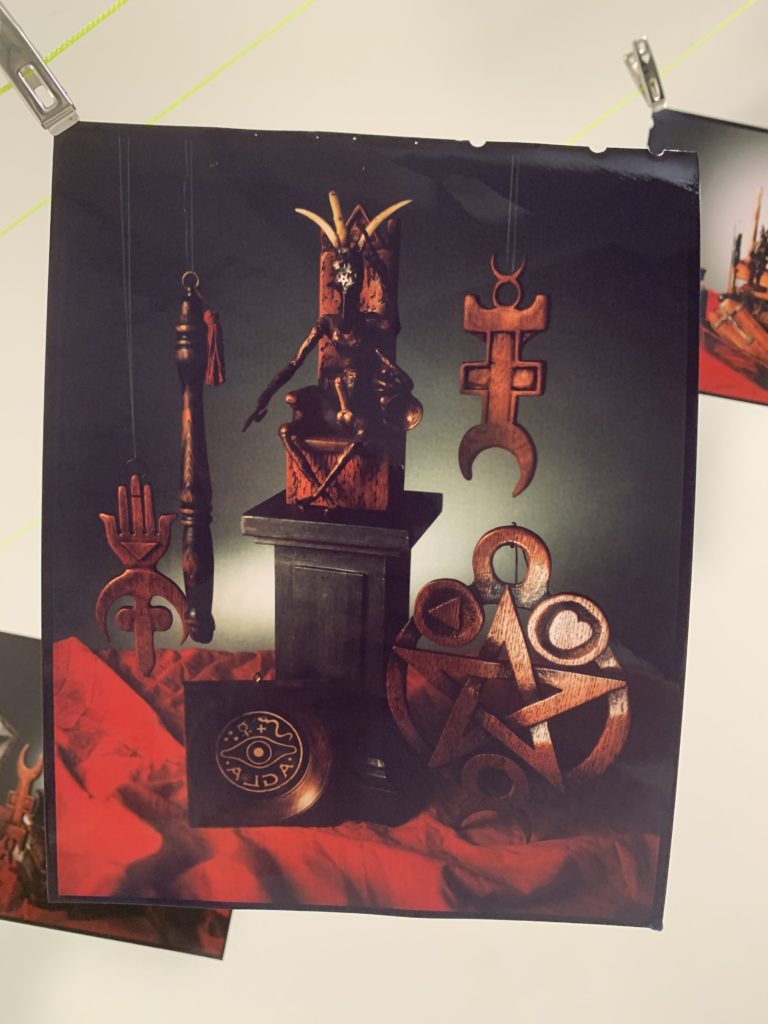
The »Richel Collection«, named after the collector Bob Richel from the Netherlands, is part of the MWM since 2000. Author Wilmar Taal has dedicated several books to the collection and Bob Richel. Foto: © Museum of Witchcraft and Magic
Simon Costin: I am an inveterate collector, having been brought up by antique collector parents who distilled in me a sense of objects having their own life and existence. Consequently I am registered on numerous auction sites and am always on the lookout for objects, books and manuscripts to enlarge and enrich the museums collection, within the limited budget we have available. I have also spent many years nurturing friendships with Craft Elders to try and ensure that should they wish, their magical tools, Books of Shadows, robes etc will be conserved and properly looked after should they want to pass them on to the museum at any point. So much has been lost already or is stuck in boxes and unseen even when the person who left their objects to a group or individual, intended them to be shared and seen by others. The museum offers a safe space where their legacy will be cherished and interpreted for future generations.
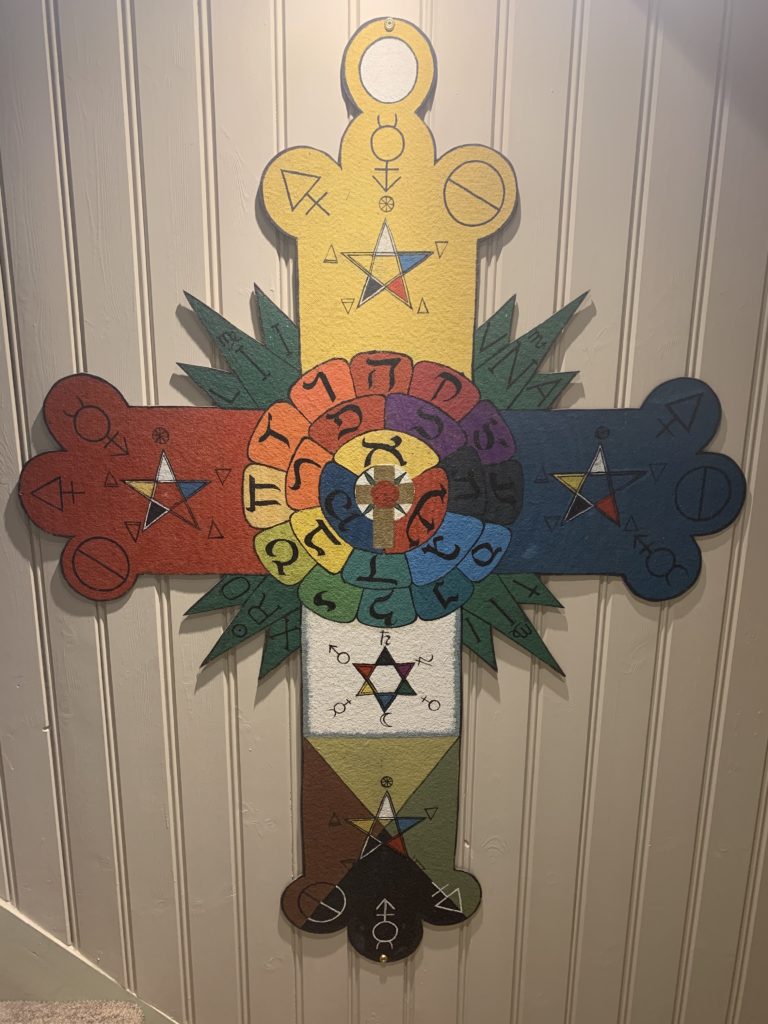
A »Rose Cross« lamen as worn in the second, inner order of the »Hermetic Order of the Golden Dawn«, the »Rosae Rubae et Aureae Crucis«. It symbolizes the four (five) elements, the three alchemical or philosophical principles, and the 22 letters of the Hebrew alphabet, and the seven classic planets of Western occultism. Thus, it contains the core teachings of the order. The lamen is currently not on display but is part of the museum collection. It is one of the many items, which is not »Witchcraft« related and widens the spectrum of the MWM. Foto: © Museum of Witchcraft and Magic
Currently, I have reviewed the collection and am actively looking for certain things which myself and the team here, feel would be good to acquire to fill certain gaps within the collection. Although we are constrained by the space we have here in Boscastle, there is no reason why the museum could not expand into a satellite space in the future. It would be foolish for us to ever pretend that we could cover all aspects of magical practise but what we can do is look to keep the collection up to date so that it reflects current magical trends and interests for example.
When Graham was here there was more an emphasis on Wicca and the key figures involved with it. Over the past 30 years there has, in the UK in particular, been an interest in Chaos Magic, Luciferianism and the work of the Cultus Sabbati, established by Andrew D. Chumbley, for instance. Currently they are not touched on in the museum. The recent rise of interest in what has become known as ‘Traditional Witchcraft’, will also be examined. As you know, magical practise changes through the ages and the museum should look to reflect this as best it can. As for our criteria for accepting objects, we tend to look at whether the donation will enhance the collection overall and also tell a good story or enlighten people as to an aspect of magical practise they may not have known about before. We can’t simply accept every single item people may care to give us and we always make sure we carefully discuss together whether the item/s are, in museum language, deemed to be of such significance that they merit permanent retention and preservation.
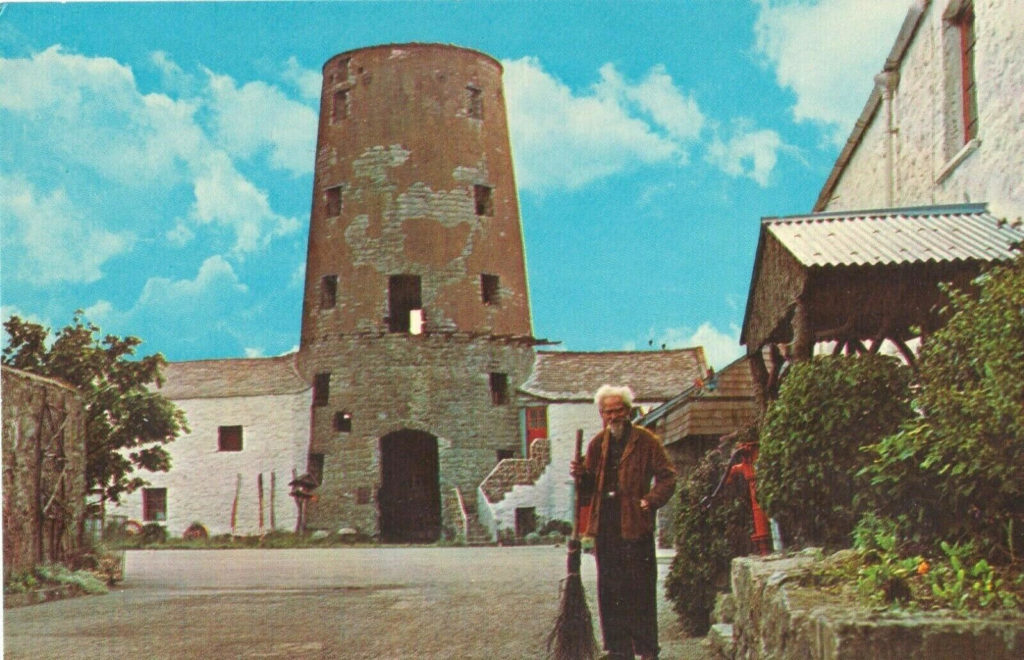
Gerald Gardner standing before the first Museum »The Witches Mill« on the Isle of Man. Foto: © Museum of Witchcraft and Magic
AH: You managed to get a part of Gerald Gardner’s heritage back to the museum. How did this come to be?
Simon Costin: I have a number of very dear friends in the states, one of whom introduced me to a man called Mark Sosnowski who had bought quite a large number of items from one of the ‘Ripley’s Believe it or Not’ sales, which happened when their various witchcraft displays were broken up and sold off. Ripley’s had bought the whole of Gardner’s collection from Gardner’s High Priestess, Monique Wilson back in 1971. Monique subsequently faced a huge amount of criticism from the Wiccan community at the time as this unique pagan legacy was lost forever. Over the years, various items have resurfaced and when I contacted Mark he said that he felt the items he had would be much better shared at the MWM and so in 2012 I journeyed to New York to meet and collect the pieces, which have been displayed here ever since.
We have also received a large number of items from Patricia Crowther, including Gardner’s favourite hat and the bag he used when exploring along with various ritual swords, athame’s and charms.
AH: What are some of your favorite items in the museum and why?
Simon Costin: This is so hard to answer because it changes all the time. Certain items will become special to me if I’m researching a particular subject and others just seem to suddenly become relevant for some unknown reason and I always try to listen to that inner voice that is telling me to focus on something because it can usually be trying to tell me something.
AH: The museum was renamed the »Museum of Witchcraft and Magic«. Why did you decide to change the name?
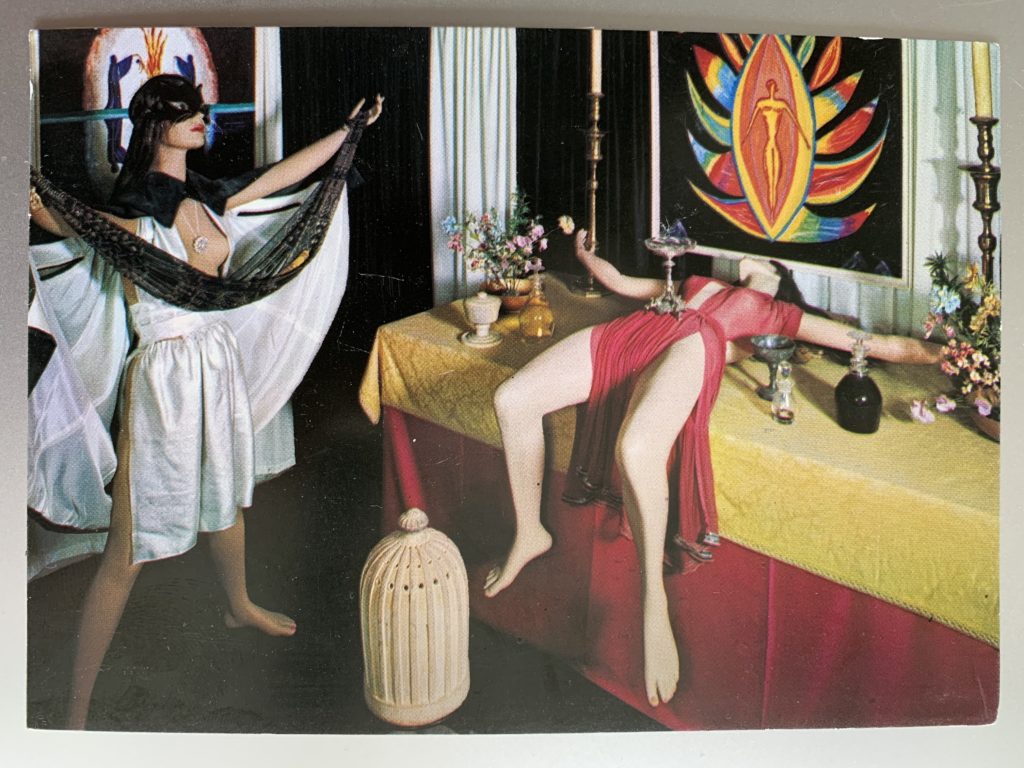
An old installation from the time before Graham King – the sometimes »lurid« approach of Cecil Williamson was replaced with a more scholarly one and the installation in the photo removed. Foto: © Museum of Witchcraft and Magic
Simon Costin: One of the first things I wanted to do when I took over the museum, was to add the word ‘magic’ as I felt that the museums collection describes far more than purely objects which relate to witchcraft alone. In it’s time the name of the museum has changed many times so I felt it wouldn’t be sacrilege to change it again!
AH: This year there appeared the first issue of the zine “Conjuration”. The limited edition of just 500 copies sold out in 16 minutes. I actually got one, but due to Corona I am not at home myself, so I have to wait until I get there to have a read. Until then, can you tell me and our readers about the authors, topics and whether this will be a constant periodical now?
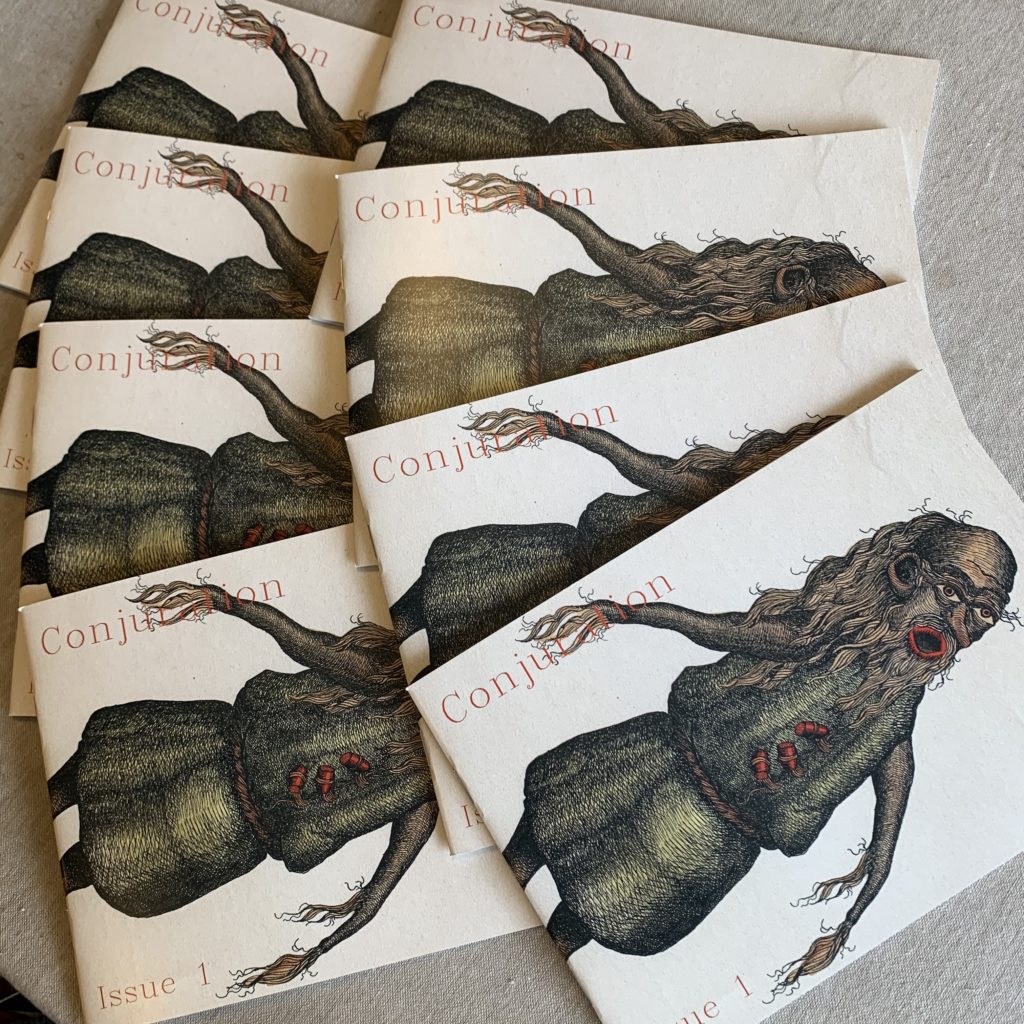
The magazine »Conjuration« issued by the MWM since 2020. The first issue was limited to 500 and sold out in just 16 minutes. Since issue 2 the number of prints is not limited anymore. Foto: © Museum of Witchcraft and Magic
Simon Costin: 2020 has been a very difficult year for us. We rely on the money from our visitors to keep going, so without that revenue stream we have had to look at other ways to survive. I was looking through our archive of zines from the 60/70/80’s and had the idea to produce our own. I took inspiration from the way they would offer up a range of ideas and articles, often with a distinct viewpoint or range of opinions. I wanted it to seem as if it was the museum itself who was the editor of the zine. As I’ve mentioned, a large part of what makes the museum so special, is the place in which it sits. The zine reflects this by opening and closing with a series of images of the landscape and sea outside the door. Recurring features are our 5 Objects project, where we ask friends and people closely associated with the museum to tell us about 5 of their favourite items from the museums collection. We have also worked with the film maker Ruth Hogben, who has edited interviews and images together and these are available to watch on our Youtube channel.
There are regular features looking at a particular item in depth, a list of divinatory practises, cuttings from Cecil Williamson’s scrapbooks, local folklore and a featured artist. We aim to bring out 4 issues each year.
AH: The museum has close ties to the occult community. What ways exist for occultists around the world to participate in the process?
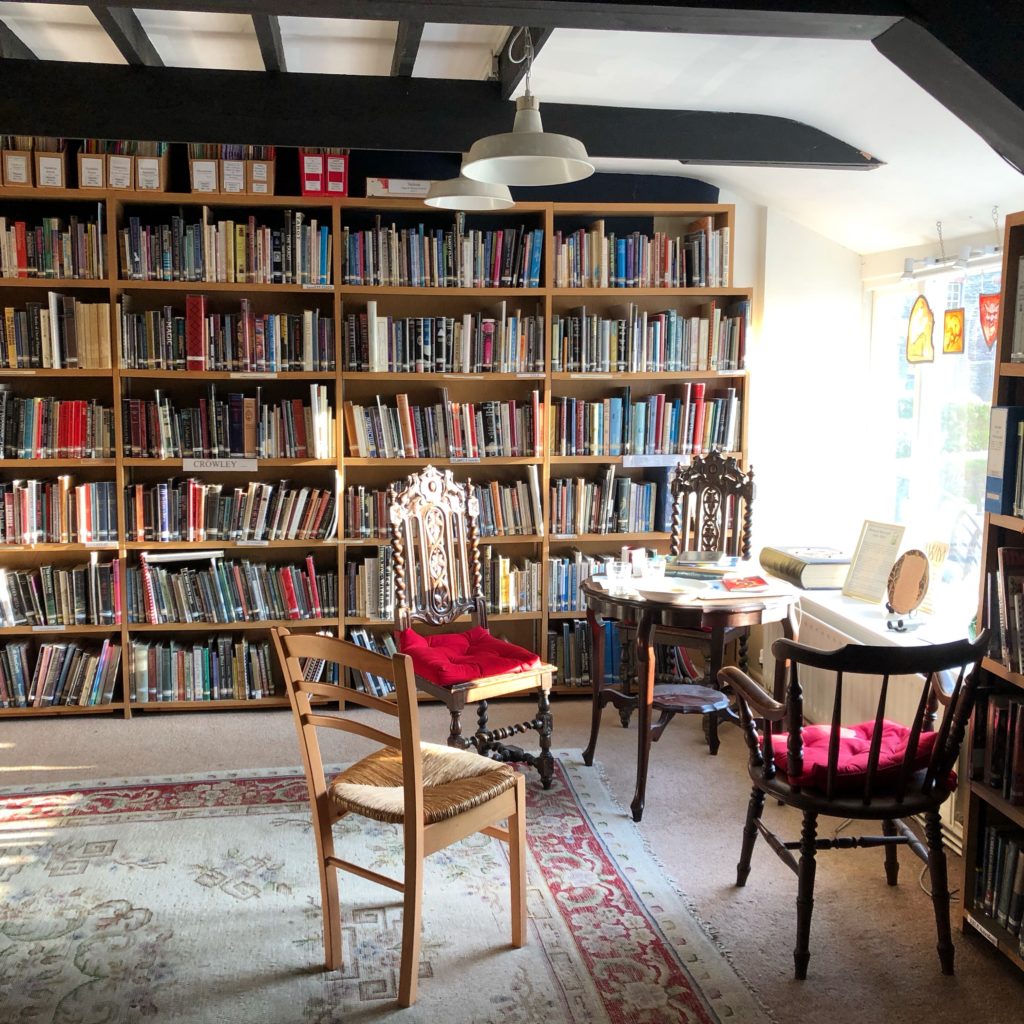
The library in the »Museum of Witchcraft and Magic» features over 7000 books and manuscripts. It is one of the several ways the museum engages with the occult community. Access is included for members of the »Friends of the Museum of Witchcraft and Magic« Foto: © Museum of Witchcraft and Magic
Simon Costin: Under normal circumstances, our vast library of books and manuscripts, are available for people to use for research purposes but this year sadly, we have been unable to offer that service. Other ways the occult community can help are by spreading the word of the museums existence, purchasing things from our online shop and contacting us should they have items of interest that they would like to donate or offer for sale.
AH: Please allow me two traditional questions at the end: Can you share with us ten books (preferably occult, but necessarily – Your passion for Joris-Karl Huysmans for example would be a good start) which influenced you the most and why do you deem these of extraordinary value?
Simon Costin:
- Apocalyptic Witchcraft, Peter Grey
- À rebours (Against Nature) Joris-Karl Huysmans
- The Passion of New Eve, Angela Carter
- The Rings of Saturn, W. G. Sebald
- Folklore, Myths and Legends of Great Britain, Readers Digest
- The Cunning Man’s Handbook, Jim Baker
- The Red Goddess, Peter Grey
- Children of Cain, Michael Howard
- The Blessing of Pan, Lord Dunsany
- His Dark Materials, Philip Pullman
It would take me months to write of their importance, so if you haven’t read any of them, please do so and draw your own conclusions.
AH: And last, but not least the fun question: What is your take on Aleister Crowley?
Simon Costin: The world would be a far duller place had he not been born…

www.Nettlesgarden.com – The Old Craft


